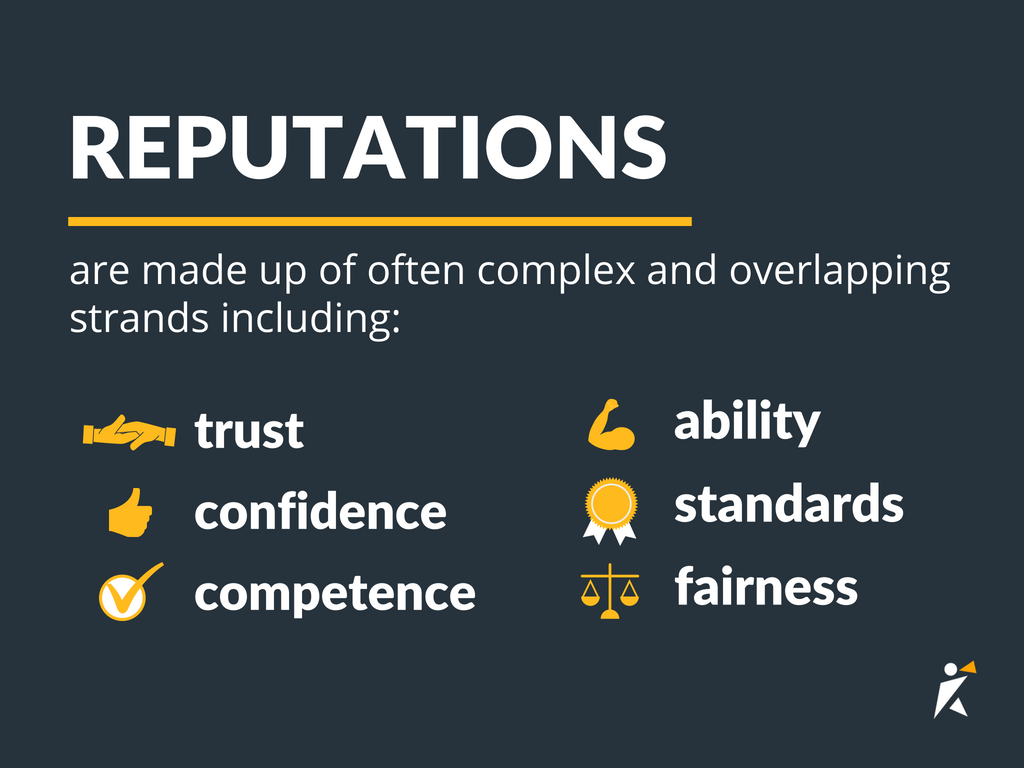How to build your reputation through influence and thought leadership

There is no doubt that reputations are critical, but they are not created overnight.
They need time and effort to build, and planning is essential.
Influence and thought leadership can play a fundamental role, but only if you invest in them.
Reputations do not happen by accident.
At the very least, action is needed to maintain and protect them.
What is often forgotten about a reputation is that it is constantly under threat.
Planned properly, influence and thought leadership can help build and protect a reputation.
What people look for in a reputation
This varies between sectors and individuals and, at least in part, explains why definitions of reputation can be a little difficult to pin down. The Financial Times considers that:
“The term refers to the observers’ collective judgments of a corporation based on assessments of financial, social and environmental impacts attributed to the corporation over time”
Leslie Gaines-Ross, author of Corporate Reputation suggests it:
“Refers to how positively, or negatively, a company or similar institution is perceived by its key stakeholders such as employees, customers, members of the media, investors, NGOs, suppliers and financial analysts.”
Paul Argenti and Bob Druckenmiller believe that it is a “collective representation of multiple constituencies’ images of a company built up over time” (Reputation and the Corporate Brand, 2004).
The list of definitions could go on. However, what it really boils down to is what people think of you.
Some opinions will, however, be more important to you than others. Not all carry equal weight.
Their relative importance will come down to how influential they are on you or your organisation.
So typically, a political or regulatory audience, main suppliers or customers would all rank highly in the corporate sector. For charities and NGOs, what donors think of you would be of critical importance.
Reputations are made up of often complex and overlapping strands including trust, confidence, competence, ability, standards, and fairness.

These components can vary between organisations and individuals but key drivers nowadays are being seen as honest, open and transparent.
That means keeping promises you make to stakeholders—be they explicit or implicit.
For many organisations, this has become a mantra of ‘We are all in this together’.
For example, the failings of several employees in Starbucks has meant training on an implicit bias for all.
Some observers may consider this to have been an unnecessary over-reaction, but for the company itself the action was considered necessary to affirm the implicit contract it makes with its customers, communities, and staff—‘creating a culture of belonging, inclusion, and diversity’.
In his open letter to customers, Executive Chairman, Howard Schultz said “In an ever-changing society, we still aspire to be a place where everyone feels welcome.”
Reputations need constant attention and they stand or fall by the quality of communications.
In the Starbucks example, the very open communications have been a deliberate strategy, and Schultz’s personal approach is not just an example of a senior executive leading from the front in a time of crisis, but also builds on his reputation and thought leadership on these issues. The company’s key stakeholders believe in the action being taken because both the leader and the company have long championed their open culture.
They have done this in a number of ways, not least through influence and thought leadership.
Mapping a path
Reputations for corporations, charities and individuals are informed by a mix of fact, perception, reporting, instinct, and relationships. So when building a reputation you need to consider all of these elements.
There are numerous tools available to help you do this. This discussion is not intended to focus on all of these but instead considers influence and thought leadership.
Good thought leadership helps secure influence and influence can help in the development of effective thought leadership.

Thought leadership is often considered as being built using a written format (books, blogs etc.) being shared over a range of channels (Twitter, Facebook, and LinkedIn). Traditional media can also be an effective channel.
It can be developed even more effectively, but with a smaller potential audience, in person (at conferences and networking events).
Thought leadership can be developed for an individual or an organisation and the aim to be seen as a thought-leader may be at the heart of a communications campaign.
A central benefit of being a thought leader is that you will stand out from others.
The best thought leaders stick to their field of expertise and understand that they are not necessarily qualified to range far and wide over unrelated matters.
Within your chosen area you can help with horizon scanning and pushing new thinking, but be wary of purporting yourself as a thought leader in areas that are not within your scope of expertise, just because they are trendy or media obsessions.
It takes time to build a reputation for thought leadership. The rewards are not delivered instantly and you should not expect your target audience to suddenly start listening to you and respecting your opinion.
How should you consider developing your thought leadership?

-
Latest issues
Be sure to respond promptly to the latest developments in your field. This is when the potential for media opportunities is at its greatest, and audiences will pay more attention to immediate reactions to something new.
-
Say something new
Draw information from a range of sources and try to find an angle or interpret the information in a way that others are missing. This is the sort of insight that policy-makers, in particular, find useful.
Whether we are still living in an era of evidence-based policy making or ‘alternative facts’, there will still be no substitute for being able to draw upon and highlight real-life experiences.
-
Bringing a new perspective
Space in a policy area can often be hard to come by so you need to identify and utilise your own space.
The perspective should reflect that space and should not reflect narrow commercial interests either. That could mean building the ability to draw thoughts up from within the organisation.
-
Ensure that what you say is genuine
If your position smacks too much of political or media posturing then it will not have the impact you are seeking. That sort of position can be too easily dismissed.
Instead, it has to be reflective of a genuine understanding of the matter at hand and a personal commitment.
Anything that smacks of opportunism should be avoided as it will undermine your thought leadership credentials.
-
Think beyond your sector
When devising your narrative you should reflect upon how the topic impacts on others outside of your interests or sector. For instance, a new policy that has consequences for you and your organisation, may have different consequences for others.
-
Draw in others
Collaborate with others to help strengthen your own thought leadership credentials. It may also help you ‘borrow’ from their reputations as well. Just be careful whom you choose, as reputations can be damaged by association too.
Know your audience
Someone aspiring to be a thought leader needs to be aware of the interests of their intended audience.
Publishing or live-streaming your latest thoughts without planning how to reach your intended audience will achieve nothing.
Momentum is important in building an audience and securing the influence you are seeking. That is about keeping the flow of good ideas going. Remaining at the forefront of people’s minds, refreshing them and providing insight. Over time they will know that you are a go-to person.
You need to consider what your intended audience wants to know. That means taking the time to find this out.
That can happen informally through discussions or more formally through, say, surveys.
Consider what may be of interest to your audience about your actions, behaviour and public positions.
To be an effective thought leader also requires you to stay up-to-date with what your ‘competitors’ are up to.
You need to be widely read and aware of the latest trends so that you can consider how they might be relevant to your audience.
Of course, you need to have a personal interest in the issues you are considering but you need to reflect the issues that your audience wants answers to.
Building the influence
If you are offering your intended audience something of relevance and value to them, then your influence will grow.

Influence also means maintaining contacts and building them over time. Be proactive through your networking and use opportunities to strike up new relationships.
You have to get your thoughts to the people that matter; you cannot rely on luck for them to find you. Recommendations are really useful; ask for help from those who already have access to your main targets.
Your planning process needs to include a strategy for growing your influence over time and improving your networking in areas where it may be weaker.
But why bother with all this hard work?
A good reputation will open up new opportunities.
For example, for SpeakerHub members the aim may be to open up new speaking opportunities. More relevant speaking opportunities are secured through having a good reputation in your field. The stronger your reputation, the more likely speaking opportunities are to be secured. Building reputation helps to create a virtuous cycle.
But all sorts of other opportunities could open up as well—involvement in other organisations, consultancy roles, requests to give expert advice.
You may get lucky and be found but there is no substitute for putting the work in to generate opportunities.
You should never assume that your strengths and abilities are obvious to all. Instead look for ways to communicate them not least indirectly through your thought leadership efforts.
Consideration also needs to be given to potential reputational threats as well. These can come from a variety of sources.
In some cases they may be as the result of a crisis—something that impacts on a person or an organisation from their own (mis)behaviour, the failure to deal with an issue quickly, or close down a risk that they should have taken action against in advance.
They can also arise from the actions of competitors or politicians, attacks from outside on business models and practices.
Always have a plan for what to do if something goes wrong. If you have been growing your influence sufficiently then you will at least have some contact with the people who really matter for your reputation.
Immediate steps
What steps should you take to build your reputation through influence and thought leadership?
-
Take the time to identify and understand your audience.
How can you bring value to them?
What are their needs?
Talk to them to gain insights into what would be useful to them. This is laying a solid foundation for making a reputation.
-
Learn from your peers.
What has worked for them and whose work do you admire most?
-
Be the expert, the authority.
That also entails looking for opportunities to be proactive.
-
Networking.
Don’t neglect opportunities to spread the word and sign people up.
-
Be on top of the relevant industry issues.
This will help you deliver thinking that your audience will want to know.
Always deliver.
Keep your knowledge current and maintain momentum in your output.
You should be relentless in your pursuit of opportunities to influence.
About the Author:
Stuart Thomson is a public affairs and communications specialist advising organisations on all elements of their public affairs strategies including political and corporate communications and reputation management.





